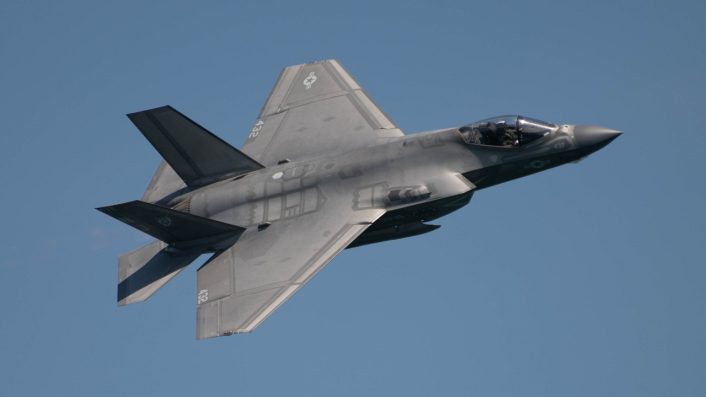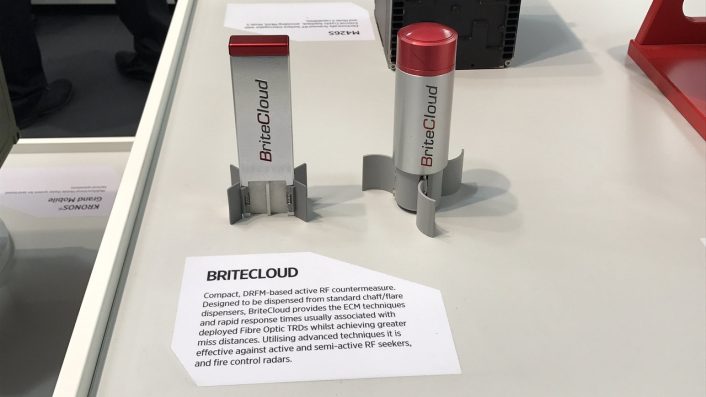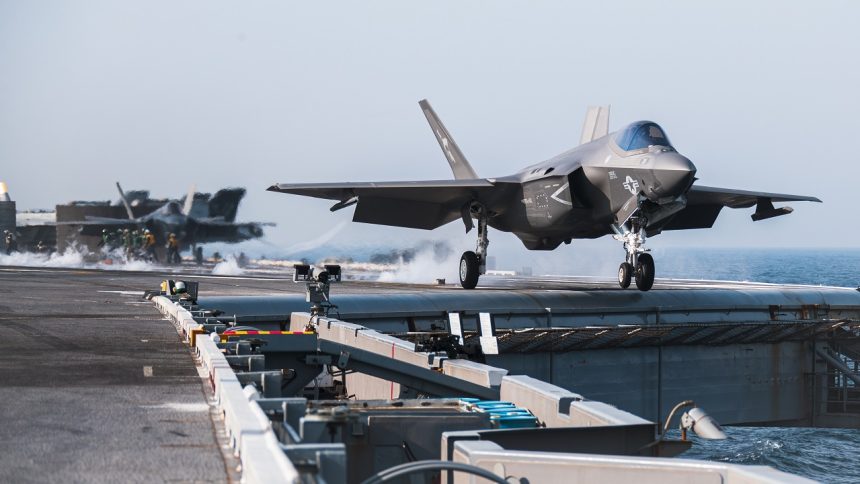After the approval for the fielding on the Air National Guard’s F-16s, it appears that that Leonardo’s BriteCloud might soon find its way on the 5th gen fighter.
The Naval Air Systems Command (NAVAIR) recently announced with a contract opportunity notice its requirement to procure Active Expendable Decoys (AED) for the F-35 Lightning II. It appears that Leonardo U.K. has been named as the sole source for this contract, making BriteCloud the likely candidate.
The proposed class of contracting actions will procure a best estimated quantity of approximately 1,000 AEDs per year for the first two years, increasing to approximately 2,000 for follow-on years, as well as initial spare impulse cartridges, support equipment, support equipment repairs and field service representatives for Fiscal Year (FY) 2025 through FY2029, says the notice.
As part of the notice, NAVAIR wrote that the AED solution must meet the following requirements:
- 2″ x 1″ x 8″ form factor
- Mission load programmable by the Government
- Demonstrated RFCM performance capability evaluated at TRL-9, defined as: “Actual system proven through successful mission operations”
- Evaluated at MRL-9, defined as: “Demonstrated Low-Rate Production capability in place to begin Full-Rate production”
- Must be qualified for use on F-35 and ready for immediate production
The requirements fit the description of BriteCloud 218, a smaller variant of the 55 mm cylindrical BriteCloud round which can fit the 2”x1”x8” US-made chaff/flare dispensers, like the standard AN/ALE-47 countermeasure dispensers installed on many US aircraft. The U.S. Air National Guard has issued a “fielding recommendation” for the decoy after the successful completion of the Foreign Comparative Testing on the service’s F-16 Fighting Falcon fighter jets in 2022.
NAVAIR also mentioned that F-35 aircraft have tested and integrated AED capability, which resulted in a fielding decision, however no other details were disclosed. Aviation Week wrote that, a year ago, the F-35 Joint Program Office acquired a Saab BOL countermeasure dispenser, which can also employ BriteCloud, to use in a flight demonstration.
In 2021, some unconfirmed rumors already reported that BriteCloud could have been eyed for integration on the F-35 Lightning II. While Leonardo could not confirm as it was not aware of these reports, they stated that the integration is possible on any aircraft which can accommodate 55mm or 2x1x8 inch expendables, with no further aircraft modification required.
It is worth mentioning that the F-35 already operates with the BAE Systems ASQ-239 onboard self-protection system, which can include the ALE-70 fiber-optic towed decoy. The decision to equip the F-35 with BriteCloud represents a significant enhancement to the aircraft’s survivability, as the aircraft is not equipped with chaffs and only a limited number of ALE-70 decoys can be carried.

Foreign Comparative Testing with the ANG
In 2022, the U.S. Air Force’s Seek Eagle Office approved Leonardo’s BriteCloud 218 Expendable Active Decoy to be flown on Air National Guard F-16C Block 30 aircraft as part of the Defense Department’s Foreign Comparative Testing (FCT) program. The operational testing program, first announced in 2019, was then completed in late 2022.
Leonardo mentioned that the F-16 fighters could be equipped with the BriteCloud 218 decoy without needing to modify the platform or perform expensive integration work. Shortly before that announcement, Italian Air Force Tornados and Royal Danish Air Force F-16s successfully demonstrated both BriteCloud 55 and BriteCloud 218 rounds at the RAF Donna Nook air weapons range in Lincolnshire.
After the completion of the FCT, the ANG said “is confident that the decoy meets and, in some instances, even exceeds operational requirements, delivering an increased platform protection capability to 4th generation fighter aircraft”. With the fielding recommendation, the U.S. Air Force has now subsequently designated BriteCloud 218 as AN/ALQ-260(V)1, identifying it as an airborne electronic warfare countermeasure.
BriteCloud
As we reported in an in-depth story in 2021, BriteCloud is a battery powered, self-contained cartridge that provides an off-board jamming capability that can be dropped like the classic chaffs and flares, creating a large distance between the aircraft and the decoy so the missile and its shrapnel miss completely the aircraft.
According to Leonardo, BriteCloud has the capability to defeat the majority of RF-guided surface-to-air and air-to-air threat systems, including the ones that rely on the “home-on-jam” guidance. After BriteCloud is ejected, it starts to search for priority threats, collecting the incoming radar pulses and cross-referencing them against a pre-programmed threat library.

Upon finding a match, BriteCloud’s on-board computer applies its advanced algorithms to simulate a “false target” so accurate that the threat system cannot detect the deception and distinguish it from the real aircraft. “BriteCloud is substantially more effective than traditional countermeasures such as chaff decoys because its technology allows BriteCloud to tailor its powerful electronic ghost signal to the specific threat radar, allowing it to defeat modern, sophisticated threats,” says Wayne Smith, Leonardo UK’s vice-president sales, electronic warfare.
Leonardo is currently the only company which succeeded in sufficiently miniaturizing the Digital Radio Frequency Memory (DRFM) technology to the point where it can be launched from a standard 55 mm chaff and flare dispenser (“the size of a drinks can”, as the company described it). With these characteristics, BriteCloud requires minimal platform integration as it just needs to be loaded in the chaff/flare dispensers.
BriteCloud is being developed in three variants: BriteCloud 55, the 55 mm cylindrical variant already operational on the RAF Typhoons and that will equip the Gripen E; BriteCloud 218, the squared 2”x1”x8” format for US-made chaff/flare dispensers; BriteCloud 55T, currently in development for transport aircraft and helicopters. Speaking to FlightGlobal, Smith said that interest in the BriteCloud 55T has risen since the Russian invasion of Ukraine.









